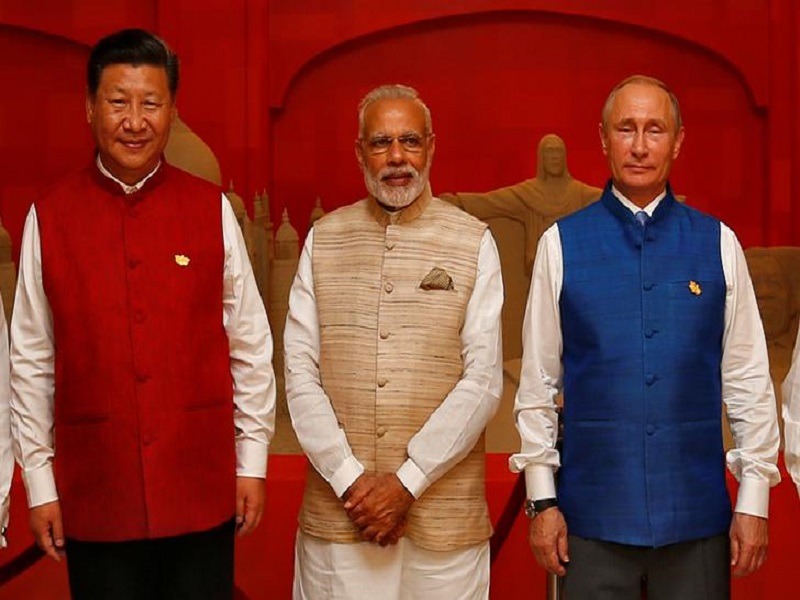BAD NEWS FOR THE WORLD: India, US are on pathway to contain China

 M. K. BHADRAKUMAR
M. K. BHADRAKUMAR
Indian Punchline
If the United States is a declining power and China’s rise inevitable in the Indo-Pacific; if Russia regards itself as a global power and is determined to bury the US-dominated rules-based order; if the defeat of the US and NATO in the Ukraine war has become a fait accompli; if Canada was encouraged by the US to fret and fume over alleged Indian involvement in Nijjar’s killing; if Israel’s bloodbath in Gaza is actually genocide — well, India’s policymakers haven’t heard any of this. That is the message coming out of the US-Indian 2+2 foreign and defence ministers meeting in New Delhi on November 10.
The big picture is that after audaciously claiming the mantle of leadership of the Global South as recently as in September, in a span of over two months, India is gliding over to the American camp as the US’ indispensable ally, even aspiring to be a “global defence hub” with Pentagon’s help.
The following were some of the takeaways at the 2+2 meeting:
- Maximisation of the scope of the Logistics and Exchange Memorandum Agreement, and identify steps to enhance the reach of the US naval vessels to Indian bases.
No doubt, the above is only the tip of the iceberg, while this extraordinary transition in Indian policies will largely remain behind closed-doors. The US seems supremely confident that India is ready to enter into an exclusive alliance, something that New Delhi never sought with any big power. What is the offer that the Biden Administration has made to India that the latter cannot refuse?
Clearly, such a massive shift in India’s military policies needs to be co-related with the fundamental postulates of foreign policy. That said, curiously, call it “bipartisan consensus” or whatever, India’s main opposition party apparently couldn’t care less about the shift. This is not surprising. The shift is actually about a nascent India-US alliance to counter China — and that is a policy front where it is difficult to choose between Tweedledum and Tweedledee.
To be sure, both Russia and China understand that Indian foreign policy is transitioning. But they pretend not to notice and would hope it is an aberration. At any rate, neither Russia nor China can stop India on its tracks. Their capacity to leverage Indian policies has dramatically shrunk — Moscow’s in particular — in the contemporary security environment.
The heart of the matter is that India is not ecstatic about the growing multipolarity in the world order. India is a beneficiary of the “rules-based order” and feels far more comfortable with a bipolar world order where multipolarity, if at all, remains a fringe phenomenon while the US’ pre-eminence will continue to prevail for decades to come. Such a paradigm is perceived as advantageous for India to navigate its pathway toward checking China’s hegemonic instincts while also optimally developing its own comprehensive national power. It is an ambitious agenda which is risky too, as policies change in Washington as presidents come and go and American interests get redefined and priorities change.
Today, however, the Indian willingness to align with the US is more evident than ever before. The animus against China’s rise was palpable at the 2+2 meeting. India has cast away any residual pretensions and is shifting toward an openly adversarial relationship with China. The QUAD has become an important locomotive. To be sure, a Chinese response can be expected — when or in what form, time will tell.
This is only possible because Delhi feels reasonably assured that Washington’s Indo-Pacific focus remains intact under the Biden Administration despite growing engagement with China. Of course, an inflection point is arising as Chinese President Xi Jinping will make his first trip to the US in five years and a summit meeting with President Biden has been meticulously prepared, which both sides hope will be productive and make the Sino-American relationship more predictable.
The three regional issues that figured prominently at the 2+2 were Afghanistan, Ukraine and the Palestine-Israel conflict. The Joint Statementdevoted a separate paragraph with the sub-title Afghanistan, which implicitly accused the Taliban rulers of not adhering to their “commitment to prevent any group or individual from using the territory of Afghanistan to threaten the security of any country.”
The joint statement goes on to pointedly recall UNSC Resolution 2593 (2021), which specifically “demands that Afghan territory not be used to threaten or attack any country or to shelter or train terrorists, or to plan or finance terrorist attacks.”
Delhi is making a radical departure from its attempts to constructively engage with the Taliban rulers. One reason could be intelligence inputs to the effect that Afghanistan is once again becoming a revolving door for international terrorist groups.
A second possibility could be that the US and India share a sense of exasperation over the Taliban’s growing proximity with China and the spectre of Afghanistan turning into a hub of the Belt and Road Initiative. Beijing’s plan to build a road connecting Afghanistan via Wakhan Corridor is a game changer in geo-strategy which is profoundly consequential. Anything that relates to the security of Xinjiang cannot but be a matter of incessant interest to Delhi.
The 2+2 joint statement signals a renewed US-Indian convergence on Afghanistan. How far this would translate as proactive moves is a moot point. Notably, the US and its allies are also exploiting Russia’s preoccupations with the conflict in Ukraine to double down on their post-cold war strategy to roll back Russian influence in Afghanistan. Moscow senses that it is losing ground in its backyard.
When it comes to Ukraine and the Palestine-Israel conflict, what emerges is that the US and Indian sides have succeeded in harmonising their respective positions on these crucial regional conflicts. In reality, Delhi is shedding its strategic ambivalence and moving towards the US position. This comes out in the strokes in the joint statement by what it says and what it doesn’t. Thus, on Ukraine, Russia’s attritional war has “consequences predominantly affecting the global South.” This apart, Moscow can learn to live with the 2+2 formulation on the Ukraine war.
As regards the West Asian situation, the joint statement voices vehement support for Israel’s fight against “terrorism”. But here, again, India refuses to call out Hamas. Nor is India endorsing Israel’s war on Hamas, leave alone pre-judge its chances of success. Most important, the joint statement omits any reference to Israel’s so-called “right to self-defence”, a mantra that is constantly on Biden’s lips.
India cannot possibly call the Gaza war an act of “self defence” when Israel has unleashed such a brutal military operation against hapless civilians and razed Gaza City to the ground — reminiscent of the joint British-American aerial bombing attack on the city of Dresden, the capital of Saxony, during World War II on the horrific night of 9-10 March 1945 killing over 25000 German people.
Perhaps, all these diplomatic peregrinations through the valley of death could be better understood against the backdrop of the intense back channel dealings involving Hamas leadership in regional capitals in which Biden administration would have high stakes and is a participant.
 Ambassador MK Bhadrakumar was a career diplomat for three decades in the Indian Foreign Service with multi-year assignments in the former Soviet Union, Pakistan, Iran, Afghanistan and Turkey. MK writes extensively on the geopolitics of Eurasia, China, West Asia and US strategies. He is a columnist at The Cradle, writes a popular blog called Indian Punchline, and is a syndicated columnist worldwide.
Ambassador MK Bhadrakumar was a career diplomat for three decades in the Indian Foreign Service with multi-year assignments in the former Soviet Union, Pakistan, Iran, Afghanistan and Turkey. MK writes extensively on the geopolitics of Eurasia, China, West Asia and US strategies. He is a columnist at The Cradle, writes a popular blog called Indian Punchline, and is a syndicated columnist worldwide.Print this article
The views expressed herein are solely those of the author and may or may not reflect those of The Greanville Post. However, we do think they are important enough to be transmitted to a wider audience.
![]()
Unfortunately, most people take this site for granted.
DONATIONS HAVE ALMOST DRIED UP…
PLEASE send what you can today!
JUST USE THE BUTTON BELOW
| Did you sign up yet for our FREE bulletin? |
[premium_newsticker id=”211406″]

This work is licensed under a Creative Commons Attribution-NonCommercial 4.0 International License














